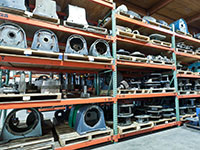 The Occupational Safety and Health Administration (OSHA) has strict regulations regarding the appropriate safety measures required when working with industrial power transmission equipment, but did you know it is not the responsibility of the parts manufacturer to ensure safety? According to OSHA, it is up to the employer to make sure the mechanical power transmission products used by his or her employees are properly guarded. Without proper safety measures, the frequency and severity of on-the-job injuries soars. The following article explores the importance of safety measures for power transmission equipment, a brief history of industrial safety, common safety issues, and the best ways to minimize and prevent accidents.
The Occupational Safety and Health Administration (OSHA) has strict regulations regarding the appropriate safety measures required when working with industrial power transmission equipment, but did you know it is not the responsibility of the parts manufacturer to ensure safety? According to OSHA, it is up to the employer to make sure the mechanical power transmission products used by his or her employees are properly guarded. Without proper safety measures, the frequency and severity of on-the-job injuries soars. The following article explores the importance of safety measures for power transmission equipment, a brief history of industrial safety, common safety issues, and the best ways to minimize and prevent accidents.
A Brief History of Industrial Safety
Industrial labor in the United States hasn’t always been a safe occupation. In the 1906 novel The Jungle, Upton Sinclair exposed the terrible working conditions of Chicago’s meat-packing industry, a story that prompted the U.S. Government to establish the Bureau of Chemistry, which would later become the Food and Drug Administration. Fast-forward sixty-four years to December 30, 1970, when President Nixon signed into law the Occupational Safety and Health Act, a bill that created OSHA. Since then, the government agency has worked to prevent occupational injuries, illnesses, and fatalities by issuing and enforcing standards for workplace safety. With the development and use of today’s complicated mechanical power transmission products, the need for industrial safety is higher than ever.
Common Safety Issues
Most mechanical hazards occur around equipment with moving parts; specifically, around the point of operation or the point of power transmission.
The point of operation is the part of the machine that does the required job. These parts are hazardous for obvious reasons – a saw blade or drill bit are very dangerous to humans. There are less obvious threats here as well, though, including lacerations and puncture wounds from flying materials or worn parts.
The point of power transmission is the part of the machine where power is transferred from the motor to the point of operation. Examples of power transmission points include pulleys, belts, and levers. These parts are often the cause of crushed limbs and entangled hair or clothing. When something goes wrong at a point of power transmission, injuries can occur and lives can even be lost.
Common Safety Equipment
One of the first steps in protecting workers from occupational injuries is providing them with appropriate protective gear. The following items help minimize risk when working around mechanical power transmission products.
1. Head shields/masks
When goggles aren’t enough, full protection head gear may be required. This can include hard hats, gas masks, and smoke hoods.
2. Ear plugs
Loud machinery can lead to partial or total deafness in workers. Ear plugs or noise-reduction headphones are the best way to prevent and minimize noise damage. Also put in place noise reduction strategies for your power transmission equipment.
3. Gloves
An essential piece of safety gear, gloves can help prevent hand injuries when dealing with hot moving parts.
4. Breathing support equipment
In some cases, breathing masks or other support equipment is needed to prevent or reduce lung damage in workers.
Preventing and Minimizing Accidents
Industrial safety means more than just providing adequate protective gear to workers. There are a number of safety measures a company can take to help prevent and minimize on-the-job accidents.
1. Follow OSHA guidelines
The suggestions and requirements outlined by OSHA help pave the way for a safe work environment. The OSHA Machine-Guarding Standard tells you exactly how to know if power transmission equipment requires special safeguards: “Any machine part, function, or process which may cause injury must be safeguarded. When the operation of a machine or accidental contact with it can injure the operator or others in the vicinity, the hazard must either be controlled of eliminated.”
2. Use appropriate guards
The right safeguarding equipment can mean life or death to workers. Chip shields, rigid barriers, and protective panels all help reduce accidents. OSHA also requires that emergency stops be within arms distance of the machine operator at all times.
3. Hire a professional
Sometimes it’s best to outsource. Hiring an independent, third-party company to investigate facilities is a great way to determine risk.
Industrial safety is no joke, especially when working environments involve power transmission equipment. Luckily, OSHA, along with a number of independent risk-assessment organizations, can help a company determine the risk of its facilities and, if needed, get everything up to code as soon as possible.
Posted under Tips and Tricks on Wednesday, April 27th, 2011
